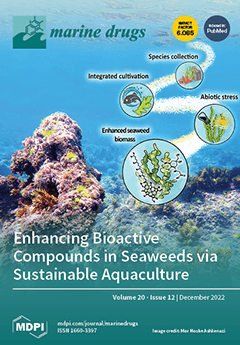Nature-based and sustainably sourced cosmetics have been dominating the area of skincare products worldwide. Due to their antioxidant and antiaging properties, compounds from cyanobacteria, such as carotenoids and phycobiliproteins, may replace synthetic ingredients in cosmetic formulations and may be used in products such as sunscreens, skincare creams, and makeup. In this study, we evaluated the potential of acetonic and aqueous extracts from cyanobacteria strains of the genera
Cyanobium and
Leptothoe and from strains within Synechococcales and Oscillatoriales orders, for use in cosmetics. Extractions were sequentially performed with acetone and water. Extracts were firstly analyzed for their toxicity to keratinocytes, fibroblasts, and endothelial cells (HaCAT, 3T3L1 and hCMEC/D3, respectively). The non-cytotoxic extracts were characterized in terms of total proteins, carotenoids, chlorophyll, phenols, phycobiliproteins, and analyzed for their antioxidant potential against the superoxide anion radical (O
2•−), and for their ability to inhibit key enzymes associated with the skin aging process. Aqueous extracts were richer in total proteins and phycobiliproteins. The aqueous extracts of Synechococcales cyanobacterium LEGE 181157 and Synechococcales cyanobacterium LEGE 181150 showed the highest value for total proteins (760.81 and 695.25 μg BSA mL
−1dry extract, respectively) and the best values regarding O
2•− scavenging (IC
50 = 63.24 and 112.18 μg mL
−1dry extract, respectively) with a significant negative correlation observed (
p < 0.01). Moreover, aqueous extracts of Synechococcales cyanobacterium LEGE 181150 and Synechococcales cyanobacterium LEGE 181157 inhibited hyaluronidase, (IC
50 of 483.86 and 645.06 μg mL
−1dry extract, respectively), with a significant negative correlation with total proteins (
p < 0.05), pointing out the contribution of these compounds to the biological activities observed. Acetonic extracts were richer in carotenoids and phenols. Zeaxanthin and β-carotene were predominant among all strains, being present in higher amount in
Cyanobium sp. LEGE 07175 (53.08 μg mg
−1) and
Leptothoe sp. LEGE 181156 (47.89 μg mg
−1), respectively. The same strains also showed the highest values for collagenase inhibition at 750 μg mL
−1dry extract (32.88 and 36.61%, respectively). Furthermore,
Leptothoe sp. LEGE 181156 exhibited the lowest IC
50 value for tyrosinase inhibition (465.92 μg mL
−1dry extract) and Synechococcales cyanobacterium LEGE 181157 presented the best values for elastase inhibition (IC
50 of 380.50 and IC
25 of 51.43 μg mL
−1dry extract). In general, cyanobacteria extracts demonstrated potential for being used for antiaging purposes, with aqueous extracts being more efficient at free radicals scavenging and acetonic ones at avoiding degradation of dermal matrix components.
Full article






